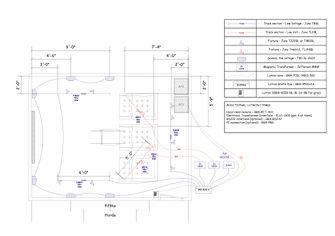Design the Ultimate Home Theater- On a Budget Page 4
OK, so lighting doesn't have much to do with acoustics. It can set the mood for your theater, however. Since we were building a room from scratch, we wanted to make sure that the lights we included were both functional and attractive. Besides, writing about lighting was a good way to get a good deal on some otherwise-expensive lighting gear. We hired lighting designer Larry Houser, whose company AVT is based in San Ramon, California. He provided us with the lighting design below, then we improvised significantly with parts from Ikea and Home Depot.

To create a theatrical effect, I knew I wanted sconce lights on the side walls ($13 apiece at Home Depot), but I originally thought we'd also need some up front so that we could see behind the front speakers. We eventually moved these lights to the rear wall. We also needed down-firing track lights above our seating position so that we can take notes. Larry included some track lights on the sides, as well, so that there would be enough light all the way around. Instead of typical track lights, we ended up using hanging-wire lights that wouldn't rattle.
A Lutron Grafik Eye will control the entire system. The Grafik Eye will allow us to control groups of lights as separate circuits and create custom modes. One mode can dim all but those lights over the seating area, so we can take notes when we're reviewing equipment. Another mode can light everything softly, which may be good for reviewing audio gear. If the room contained artwork, we could create a mode that would highlight it. The Lutron system is extremely flexible, and it comes with a remote. We like remotes.
 Tip #6: Project Management—Tips from the Trenches (aka My Time in Construction Hell)
Tip #6: Project Management—Tips from the Trenches (aka My Time in Construction Hell)
I will say this: Veteran home theater designer and project manager Russ Herschelmann warned us that project management can make or break a home theater installation. We'd agree. It's extremely important to make sure that there's one point man (or woman) for the project and that all of the involved parties, including contractors and subcontractors, coordinate their activities with this project manager. As little as a single misplaced screw can render an isolated wall or floor almost useless. You want to make sure that everyone is working with you, not just for you.
Very early on, we realized what Russ meant. In hindsight, we may not have undertaken this project if we had known what it would entail. Our first piece of advice is that, whenever possible, hire somebody else. Granted, this increases your cost; however, in the long run, finding someone like Russ, Norm, or Anthony—someone who has experience constructing a number of projects like this—can be a tremendous benefit. Much of our project management came from that first day with the three of them. Unfortunately, we barely paid them enough to visit us for the day. There was only so much information they could spew at us while sucking down free pizza and soda. If any one of these guys (particularly Russ, whose name came first on the speed dial) had a 900 number, we would've spent more in phone charges than our government spends on national defense.
 Our second piece of advice is to visit your local hardware-supply stores before you start your design phase. This may seem backwards, but take it from us: Designing the system around the less-expensive materials that are available to you will save money in the long run. We designed our floor with three-quarter-inch oriented strand board (OSB). Home Depot, our unofficial sponsor, only had three-quarter-inch plywood, which is three times as expensive as the seven-sixteenth-inch OSB that they did have. Using the latter would change the proposed height of our room. We had to jump through numerous hoops to compensate for the difference.
Our second piece of advice is to visit your local hardware-supply stores before you start your design phase. This may seem backwards, but take it from us: Designing the system around the less-expensive materials that are available to you will save money in the long run. We designed our floor with three-quarter-inch oriented strand board (OSB). Home Depot, our unofficial sponsor, only had three-quarter-inch plywood, which is three times as expensive as the seven-sixteenth-inch OSB that they did have. Using the latter would change the proposed height of our room. We had to jump through numerous hoops to compensate for the difference.
By the same token, if you're planning to do most of the work yourself, take an honest evaluation of your skills and capabilities. If you've never upholstered before, don't expect to make beautiful acoustic treatments out of cloth and bats of Fiberglas. Professionals get paid what they do because they're good at it; you're not. You may spend the same amount in trial and error if you want it to look perfect and don't know what you're doing.
 Our third tip is to take stock of your ultimate goal and budget. As I'll discuss in the construction phase next month, spending a load of money on soundproof walls and then using a cheap, poorly insulated door is like spending $10,000 on an amplifier and playing it through $50 speakers that you bought out of the back of a van. Unless you plan to upgrade the weak parts later, you may be living with subpar quality overall.
Our third tip is to take stock of your ultimate goal and budget. As I'll discuss in the construction phase next month, spending a load of money on soundproof walls and then using a cheap, poorly insulated door is like spending $10,000 on an amplifier and playing it through $50 speakers that you bought out of the back of a van. Unless you plan to upgrade the weak parts later, you may be living with subpar quality overall.
Our fourth and last bit of advice is to have fun. Period. The process of building your dream theater, regardless of your budget, should be as much fun as using the system itself. If you hate doing manual labor or calculating mathematical formulas, skip that part. While we've tried to offer suggestions for improvements, your ears are always the final judge.





























































